Welcome to our guide on Lysimachia Nummularia Green, Creeping Jenny.
This vibrant ground cover plant is a true gem in any garden or landscape, adding a touch of emerald beauty to your outdoor space.
This article will delve into the world of Lysimachia Nummularia Green, exploring its characteristics, benefits, cultivation, care, and design possibilities.
Whether you are a seasoned gardener or a beginner, we have all the information you need to make the most of this versatile plant.
As a creeping jenny ground cover, Lysimachia Nummularia Green forms a dense carpet-like mat, effortlessly spreading its vibrant green foliage.
Its cascading habit and trailing stems create a visually appealing effect, making it an excellent choice for various landscape designs.
To help you fully appreciate the beauty and potential of this plant, we will share expert tips and insights on everything from cultivation and care to design ideas.
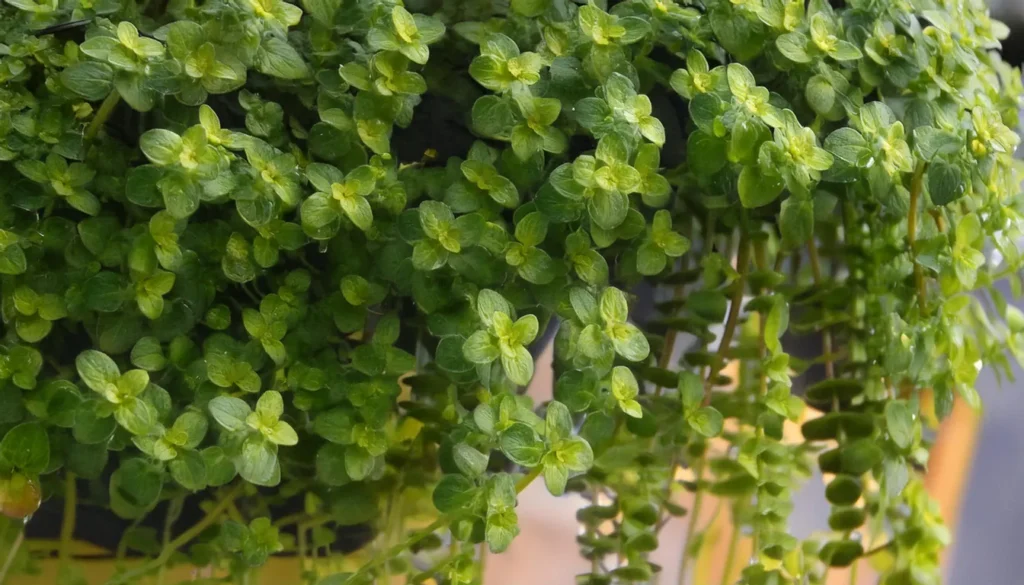
Key Takeaway
- Lysimachia Nummularia Green, or Creeping Jenny, is a beautiful ground cover plant.
- It forms a dense mat of vibrant green foliage and has a cascading habit.
- The plant offers numerous functional benefits, including erosion control and water conservation.
- Lysimachia Nummularia Green is versatile in design and can be used in various landscaping styles.
- Proper cultivation, care, and maintenance are essential for the successful growth of this plant.
Quick Stats
| Attribute | Details |
| Family Name | Primulaceae |
| Origin | Europe and parts of Asia |
| Height | 2-5 cm (0.8-2 inches) submerged, can grow taller when emersed |
| pH Range | 6.0 – 7.5 |
| CO2 Requirement | Low |
| Growth Rate | Fast |
| Care Level | Easy |
| Color Form | Bright Green |
| Water Conditions | 10-25°C (50-77°F), adaptable to a wide range of water hardness |
| Max Size | Can spread indefinitely across the substrate; individual stems can grow several inches long |
| Lighting | Low to High |
| Supplements | Benefits from liquid fertilizers; CO2 not necessary but can enhance growth |
| Placement | Foreground to Mid-ground |
| Propagation | Stem cuttings |
What Is Lysimachia Nummularia Green?
Lysimachia Nummularia Green is a low-growing perennial with trailing stems and bright green leaves.
It belongs to the Primulaceae family and is native to Europe and Western Asia.
The plant is characterized by its dense mat-like growth and cascading habit.
There are several popular varieties of Lysimachia Nummularia Green, each with its own unique features.
History And Natural Habitat
- Lysimachia Nummularia Green, also known as Green Creeping Jenny, has a rich history and has been cultivated for centuries for its ornamental value. This vibrant ground cover plant is believed to have originated in Europe and Western Asia.
- In its natural habitat, Green Creeping Jenny thrives along the edges of streams, in moist meadows, and woodland areas. It is well-adapted to these environments and can withstand varying levels of moisture and shade.
- The plant’s ability to thrive in diverse habitats demonstrates its resilience and adaptability. This natural adaptability makes Green Creeping Jenny an excellent choice for landscaping applications.
Characteristics Of Green Creeping Jenny
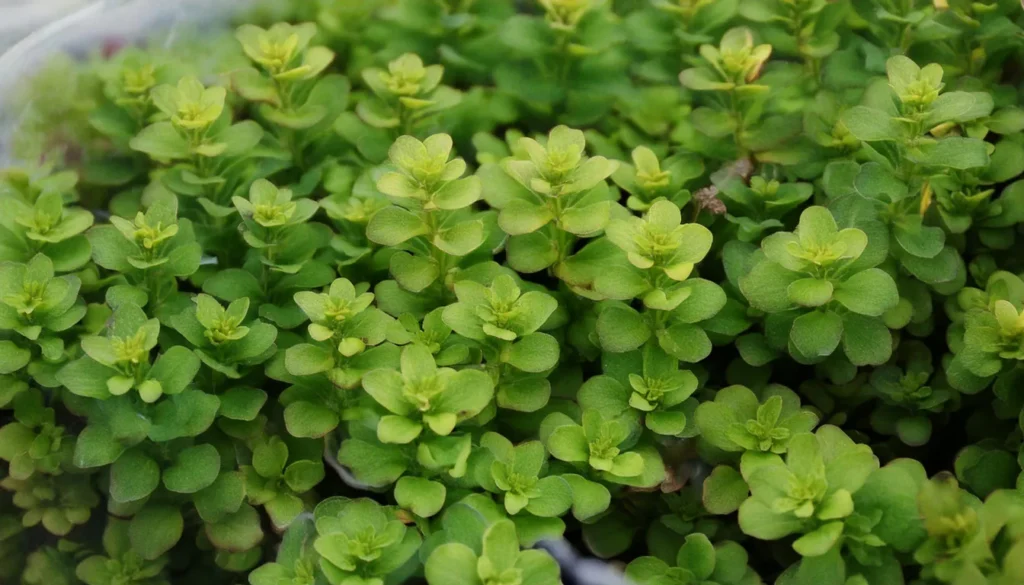
| Characteristic | Description |
| Leaves | Vibrant green, small, round, and slightly succulent |
| Growth Habit | Low-growing perennial with trailing stems |
| Propagation | Spreads through underground stems called stolons, forming a dense mat-like carpet |
| Ornamental Value | Provides a vibrant splash of green and adds aesthetic appeal to gardens and landscapes |
- One of Green Creeping Jenny’s distinguishing features is its vibrant green leaves. They have a beautiful, glossy appearance and create a stunning carpet-like effect when planted en masse.
- The plant’s trailing stems and dense growth habit make it an ideal ground cover. It quickly fills in empty spaces and helps prevent soil erosion. With its versatility and adaptability, Green Creeping Jenny can be used in various landscaping styles and designs.
Lightning Needs
- Optimal Lighting Intensity: Lysimachia nummularia benefits from moderate to high-intensity lighting in the aquarium. Providing sufficient light ensures that the plant receives the energy it needs for photosynthesis, which is essential for healthy growth and vibrant foliage coloration.
- Lighting Source: LED lights or fluorescent bulbs are commonly used in aquarium setups to provide the necessary illumination for aquatic plants like Lysimachia nummularia ‘Green’. These light sources emit a spectrum of light suitable for promoting photosynthesis and overall plant health. A color temperature of around 6500K is ideal as it mimics natural daylight conditions.
- Consistency in Lighting Duration and Intensity: Maintaining consistent lighting duration and intensity is crucial for the optimal growth of Lysimachia nummularia ‘Green’. Fluctuations in lighting can disrupt the plant’s metabolic processes and lead to stunted growth or nutrient deficiencies. Aim for a lighting period of 8-10 hours per day to simulate natural day-night cycles.
Temperature Parameter For Robust Growth
- Optimal Temperature Range: Lysimachia nummularia ‘Green’ thrives in temperatures typically found in tropical freshwater aquariums. The ideal temperature range for robust growth is between 20°C to 28°C (68°F to 82°F).
- Warmth Promotes Growth: Warmer temperatures within the recommended range stimulate metabolic processes in the plant, including photosynthesis and nutrient uptake. This leads to faster growth rates and healthier foliage.
- Temperature Stability: While Lysimachia nummularia ‘Green’ can tolerate minor fluctuations in temperature, it’s essential to maintain stability within the optimal range. Sudden temperature shifts or prolonged exposure to extremes can stress the plant and compromise its growth and overall health.
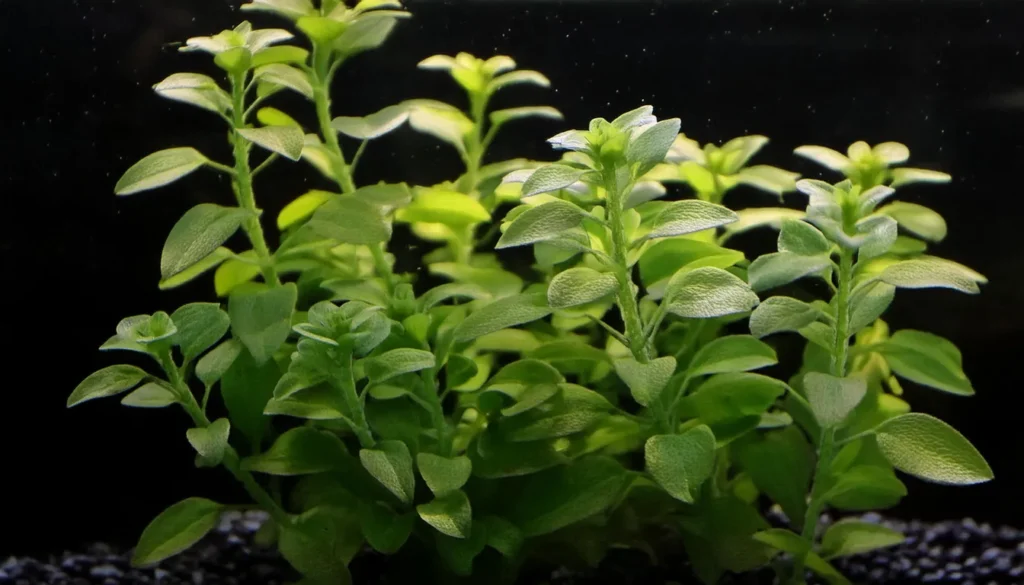
Optimal Water Condition
- pH Level: Aim for a slightly acidic to neutral pH level ranging from 6.5 to 7.5. Lysimachia nummularia ‘Green’ typically thrives in water with a pH within this range. Fluctuations outside of this range can stress the plant and hinder its growth.
- Water Hardness: Lysimachia nummularia ‘Green’ adapts well to a wide range of water hardness levels, from soft to moderately hard. However, it’s crucial to maintain stability in water hardness to prevent fluctuations that can stress the plant.
- Temperature: Keep the water temperature within the optimal range of 20°C to 28°C (68°F to 82°F). Consistent temperatures within this range promote healthy growth and metabolism in Lysimachia nummularia ‘Green’. Avoid sudden temperature fluctuations, as they can shock the plant and lead to health issues.
- Nutrient Levels: Ensure adequate nutrient levels in the water to support the growth of Lysimachia nummularia ‘Green’. Regularly test for essential nutrients such as nitrogen, phosphorus, potassium, iron, and micronutrients. Supplement with liquid fertilizers or root tabs as needed to maintain optimal nutrient levels.
Substrate Requirement
- Fine-Grained Substrate: Lysimachia nummularia ‘Green’ benefits from a fine-grained substrate that provides stability for its delicate roots. Choose substrates such as aquarium sand, fine gravel, or specialized plant substrates designed for aquatic plants.
- Nutrient-Rich Substrate: Opt for a nutrient-rich substrate to provide essential nutrients for the plant’s growth. Look for substrates labeled as “aquarium plant substrate” or “plant growth substrate” that contain beneficial nutrients like iron, potassium, and other micronutrients.
- Depth: Ensure an adequate substrate depth to allow for root development and stability. A depth of 2 to 3 inches (5 to 7.5 centimeters) is generally sufficient for Lysimachia nummularia ‘Green’. Deeper substrates may be necessary if you plan to plant the roots directly into the substrate rather than allowing them to float.
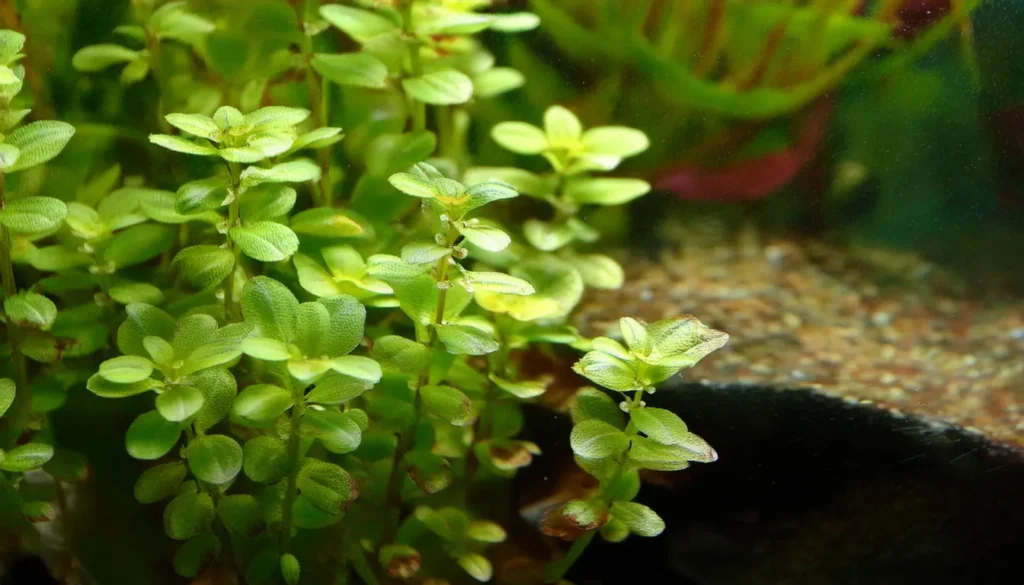
Placement Option
- Fine-Grained Substrate: Lysimachia nummularia ‘Green’ benefits from a fine-grained substrate that provides stability for its delicate roots. Choose substrates such as aquarium sand, fine gravel, or specialized plant substrates designed for aquatic plants.
- Nutrient-Rich Substrate: Opt for a nutrient-rich substrate to provide essential nutrients for the plant’s growth. Look for substrates labeled as “aquarium plant substrate” or “plant growth substrate” that contain beneficial nutrients like iron, potassium, and other micronutrients.
- Depth: Ensure an adequate substrate depth to allow for root development and stability. A depth of 2 to 3 inches (5 to 7.5 centimeters) is generally sufficient for Lysimachia nummularia ‘Green’. Deeper substrates may be necessary if you plan to plant the roots directly into the substrate rather than allowing them to float.
- Preparation: Rinse the substrate thoroughly before adding it to the aquarium to remove any dust or debris. Level the substrate evenly across the bottom of the tank to provide a uniform planting surface.
Recommended Tank Size
- For small to medium-sized aquariums: A tank with a capacity of 10 to 20 gallons (38 to 76 liters) can accommodate Lysimachia nummularia ‘Green’ effectively. This size provides ample space for planting multiple specimens and creating a lush green carpet in the foreground or midground of the tank.
- For larger aquariums: Tanks with a capacity of 30 gallons (114 liters) or more offer even more flexibility for aquascaping with Lysimachia nummularia ‘Green’. These larger tanks allow for more extensive planting arrangements and provide space for creating visually stunning landscapes with various plant species and decor elements.
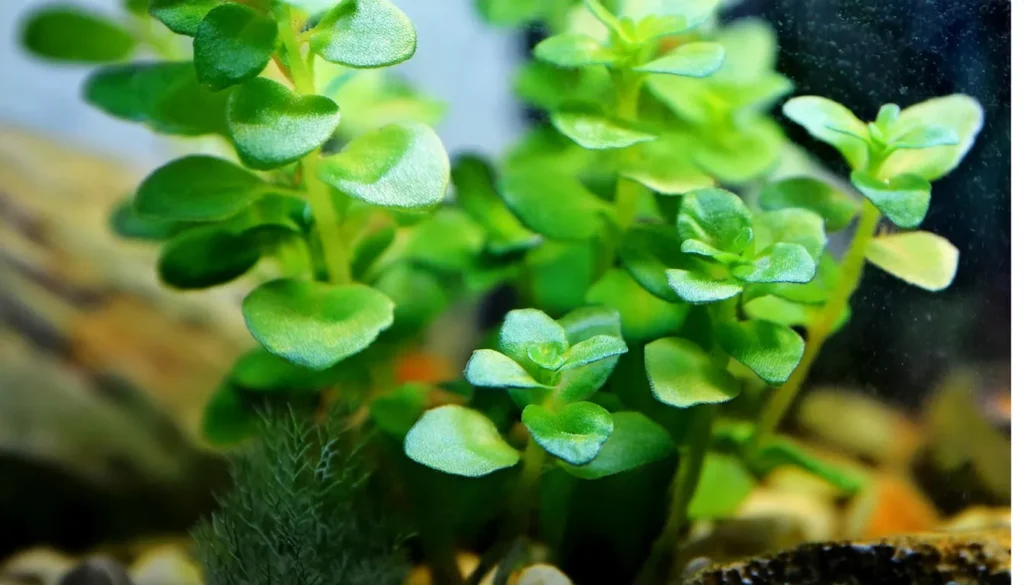
Suitable Tank Mates
- Small to Medium-sized Community Fish: Peaceful fish species like tetras, rasboras, danios, guppies, and small catfish make excellent tank mates for Lysimachia nummularia ‘Green’. They add movement and color to the aquarium without disturbing the plants.
- Shrimp and Snails: Invertebrates such as cherry shrimp, amano shrimp, and nerite snails can help keep the aquarium clean by consuming algae and detritus. They generally do not pose a threat to Lysimachia nummularia ‘Green’ and can coexist peacefully with the plant.
- Bottom-dwelling Fish: Species like corydoras catfish and otocinclus catfish are beneficial tank mates as they help clean the substrate and aquarium surfaces. Their peaceful nature makes them compatible with Lysimachia nummularia ‘Green’.
Nutritional Requirements
- Macronutrients: These include nitrogen (N), phosphorus (P), and potassium (K), which are essential for overall plant growth and function. Nitrogen promotes leafy growth, phosphorus supports root development and flowering, while potassium aids in overall plant health and disease resistance.
- Micronutrients: These are trace elements like iron (Fe), manganese (Mn), zinc (Zn), and others, which are essential for various biochemical processes within the plant. Iron, in particular, is crucial for chlorophyll production and overall leaf health.
- CO2: Carbon dioxide (CO2) is a vital component for photosynthesis, the process by which plants convert light energy into chemical energy. In planted aquariums, providing supplemental CO2 through injected CO2 systems or liquid carbon supplements can significantly enhance plant growth and vitality.
Lysimachia Nummularia Green Cultivation Tips
- Substrate: Use a nutrient-rich substrate like aquasoil or aquatic plant substrate to provide essential nutrients for Lysimachia nummularia ‘Green’. A fine-grained substrate allows for easy rooting and stability. Ensure a depth of 2-3 inches (5-7.5 cm) to accommodate root growth.
- Fertilization: Supplement the substrate with root tabs or nutrient-rich fertilizers to provide essential macro and micronutrients. Additionally, consider dosing liquid fertilizers to ensure adequate nutrient availability for the plant. Pay attention to iron supplementation to prevent yellowing of leaves.
- CO2: While not strictly necessary, providing supplemental CO2 can enhance the growth and vibrancy of Lysimachia nummularia ‘Green’. Consider using a CO2 injection system or liquid carbon supplements to ensure sufficient carbon availability for photosynthesis.
- Pruning: Regular pruning helps maintain the desired shape and density of Lysimachia nummularia ‘Green’. Trim overgrown or yellowing leaves and prune runners to prevent overcrowding and promote healthy growth.
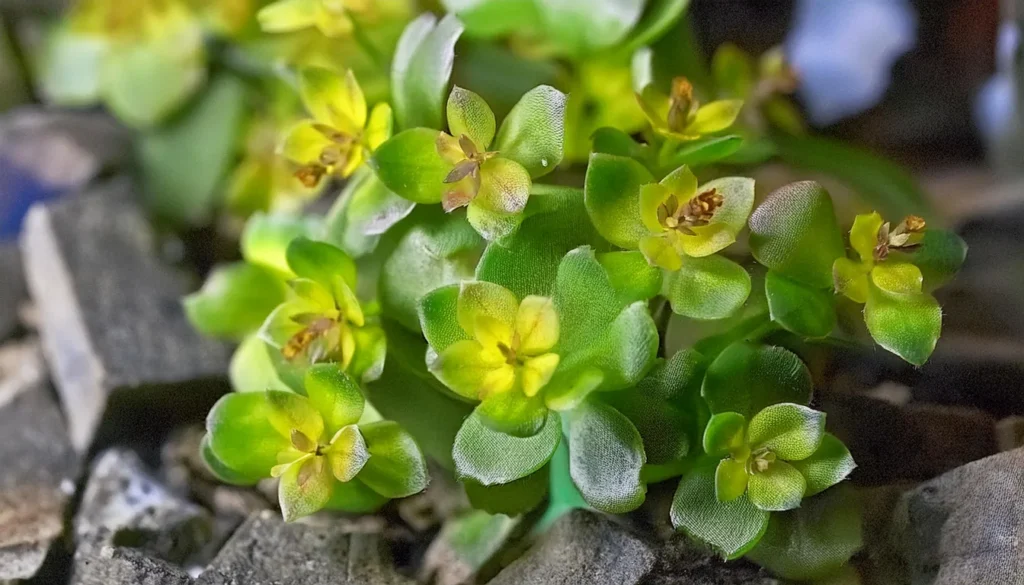
Plant Propagation Tips
- Division: Lysimachia nummularia ‘Green’ readily spreads through runners, producing new plantlets along the length of its stems. To propagate through division, carefully separate these plantlets from the parent plant using sharp scissors or pruning shears. Ensure that each plantlet has a portion of roots attached. Plant the separated plantlets in the substrate to establish new growth.
- Cuttings: Stem cuttings can also be taken from healthy portions of the plant to propagate Lysimachia nummularia ‘Green’. Use sharp, sterilized scissors to cut a portion of the stem with several leaves attached. Remove any lower leaves to expose a node where roots will develop. Plant the cutting in the substrate, ensuring that the node is buried beneath the surface. Keep the substrate moist and provide adequate lighting for root development.
- Runners: As Lysimachia nummularia ‘Green’ sends out runners, you can encourage propagation by allowing these runners to take root where they touch the substrate. Alternatively, you can gently pin down the runners using weights or small stones to promote root establishment. Once rooted, the new plantlets can be separated from the parent plant and replanted elsewhere in the aquarium.
Benefits Of Planting Lysimachia Nummularia Green
- Aesthetic Appeal: Lysimachia nummularia features bright green, round leaves that create a lush and vibrant appearance in aquatic environments. Its trailing growth habit makes it suitable for foreground or midground planting, adding depth and visual interest to the aquascape.
- Oxygenation: Like all aquatic plants, Lysimachia nummularia ‘Green’ contributes to oxygenation by photosynthesizing and releasing oxygen into the water. This helps maintain healthy oxygen levels for fish and other aquatic inhabitants, promoting their overall well-being.
- Water Filtration: The dense growth of Lysimachia nummularia ‘Green’ can act as a natural filter, helping to absorb excess nutrients and remove pollutants from the water. This can contribute to improved water quality and clarity in the aquarium or pond.
- Algae Control: By outcompeting algae for nutrients and light, Lysimachia nummularia ‘Green’ can help prevent or reduce algae growth in the aquarium. Its vigorous growth and dense foliage shade the substrate, making it less hospitable for algae to thrive.

Conclusion
Lysimachia Nummularia, also known as Creeping Jenny, is a remarkable plant that brings both beauty and functionality to gardens and landscapes.
With its vibrant green foliage and spreading habit, this versatile ground cover creates a stunning carpet-like effect that enhances the overall aesthetic appeal of outdoor spaces.
By understanding the characteristics and benefits of Lysimachia Nummularia Green and its cultivation requirements and care needs, gardeners can successfully incorporate this plant into their landscapes.
It provides erosion control, weed suppression, and water conservation, making it an excellent choice for those seeking both environmental benefits and visual appeal.
Whether used as a ground cover, a border plant, or with other companion plants, Lysimachia Nummularia Green adds a touch of elegance and lushness to any design.
Its versatility and adaptability make it suitable for various landscaping styles, from traditional to contemporary.
Incorporating Lysimachia Nummularia Green into your outdoor spaces allows you to enjoy its beauty for years while benefiting from its functional attributes.
By creating a captivating carpet of green, this plant will transform your garden into a serene and picturesque oasis.
Frequently Asked Questions
What Is Lysimachia Nummularia Green?
Lysimachia Nummularia Green, also known as Creeping Jenny, is a low-growing perennial ground cover plant with trailing stems and bright green leaves.
It creates a dense mat-like growth and cascading effect in gardens and landscapes.
How Is Green Creeping Jenny Cultivated?
To cultivate Lysimachia Nummularia Green, providing it with the ideal growing conditions is important.
This includes planting it in well-draining soil with a slightly acidic to neutral pH level and ensuring it receives adequate sunlight, preferably partial shade.
Planting involves preparing the soil, planting cuttings or divisions, and providing proper care and maintenance.
How Should I Care For Green Creeping Jenny?
Care and maintenance for Green Creeping Jenny include regular pruning and trimming to control its growth, proper irrigation to keep the soil consistently moist but not waterlogged, and preventive measures and appropriate treatments for common pests and problems such as aphids or fungal infections.
What Are The Benefits Of Creeping Jenny Ground Cover?
Creeping Jenny ground cover offers erosion control, weed suppression, and water conservation benefits.
It also adds aesthetic appeal and versatility to the design, allowing it to be used in various landscaping styles.
What Are Some Design Ideas For Incorporating Lysimachia Nummularia Green In Landscaping?
Some design ideas include utilizing companion plants that complement the vibrant green color of Creeping Jenny, such as purple or blue flowering plants.
Another tip is to create visual interest by combining Green Creeping Jenny with plants with contrasting foliage and textures, such as spiky leaves or variegated patterns.
- Unveiling The Wonders Of Riccia Fluitans In Aquascapes - August 7, 2024
- Vallisneria Gigantea Var. Guide To Care And Cultivation At Home - July 31, 2024
- Vesicularia Dubyana Care & Growth Guide Tips For Beginner Gardeners - July 30, 2024
